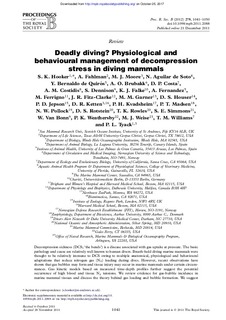| dc.contributor.author | Hooker, SK | |
| dc.contributor.author | Fahlman, A | |
| dc.contributor.author | Moore, MJ | |
| dc.contributor.author | de Soto, NA | |
| dc.contributor.author | de Quiros, YB | |
| dc.contributor.author | Brubakk, Alf O | |
| dc.contributor.author | Costa, DP | |
| dc.contributor.author | Costidis, AM | |
| dc.contributor.author | Dennison, S | |
| dc.contributor.author | Falke, KJ | |
| dc.contributor.author | Fernandez, A | |
| dc.contributor.author | Ferrigno, M | |
| dc.contributor.author | Fitz-Clarke, JR | |
| dc.contributor.author | Garner, MM | |
| dc.contributor.author | Houser, DS | |
| dc.contributor.author | Jepson, PD | |
| dc.contributor.author | Ketten, DR | |
| dc.contributor.author | Kvadsheim, Petter Helgevold | |
| dc.contributor.author | Madsen, PT | |
| dc.contributor.author | Pollock, NW | |
| dc.contributor.author | Rotstein, DS | |
| dc.contributor.author | Rowles, TK | |
| dc.contributor.author | Simmons, SE | |
| dc.contributor.author | Van Bonn, W | |
| dc.contributor.author | Weathersby, PK | |
| dc.contributor.author | Weise, MJ | |
| dc.contributor.author | Williams, TM | |
| dc.contributor.author | Tyack, PL | |
| dc.date.accessioned | 2017-10-25T14:41:32Z | |
| dc.date.available | 2017-10-25T14:41:32Z | |
| dc.date.created | 2012-05-03T10:32:12Z | |
| dc.date.issued | 2012 | |
| dc.identifier.citation | Proceedings of the Royal Society of London. Biological Sciences. 2012, 279 (1731), 1041-1050. | nb_NO |
| dc.identifier.issn | 0962-8452 | |
| dc.identifier.uri | http://hdl.handle.net/11250/2462210 | |
| dc.description.abstract | Decompression sickness (DCS; ‘the bends’) is a disease associated with gas uptake at pressure. The basic pathology and cause are relatively well known to human divers. Breath-hold diving marine mammals were thought to be relatively immune to DCS owing to multiple anatomical, physiological and behavioural adaptations that reduce nitrogen gas (N2) loading during dives. However, recent observations have shown that gas bubbles may form and tissue injury may occur in marine mammals under certain circumstances. Gas kinetic models based on measured time-depth profiles further suggest the potential occurrence of high blood and tissue N2 tensions. We review evidence for gas-bubble incidence in marine mammal tissues and discuss the theory behind gas loading and bubble formation. We suggest that diving mammals vary their physiological responses according to multiple stressors, and that the perspective on marine mammal diving physiology should change from simply minimizing N2 loading to management of the N2 load. This suggests several avenues for further study, ranging from the effects of gas bubbles at molecular, cellular and organ function levels, to comparative studies relating the presence/absence of gas bubbles to diving behaviour. Technological advances in imaging and remote instrumentation are likely to advance this field in coming years. | nb_NO |
| dc.language.iso | eng | nb_NO |
| dc.publisher | The Royal Society | nb_NO |
| dc.rights | Navngivelse 4.0 Internasjonal | * |
| dc.rights.uri | http://creativecommons.org/licenses/by/4.0/deed.no | * |
| dc.title | Deadly diving? Physiological and behavioural management of decompression stress in diving mammals | nb_NO |
| dc.type | Journal article | nb_NO |
| dc.type | Peer reviewed | nb_NO |
| dc.description.version | publishedVersion | nb_NO |
| dc.source.pagenumber | 1041-1050 | nb_NO |
| dc.source.volume | 279 | nb_NO |
| dc.source.journal | Proceedings of the Royal Society of London. Biological Sciences | nb_NO |
| dc.source.issue | 1731 | nb_NO |
| dc.identifier.doi | 10.1098/rspb.2011.2088 | |
| dc.identifier.cristin | 922668 | |
| dc.description.localcode | This is an open-access article distributed under the terms of the Creative Commons Attribution License (CC BY 4.0), which permits unrestricted use, distribution, and reproduction in any medium, provided the original work is properly cited. | nb_NO |
| cristin.unitcode | 194,65,25,0 | |
| cristin.unitname | Institutt for sirkulasjon og bildediagnostikk | |
| cristin.ispublished | true | |
| cristin.fulltext | original | |
| cristin.qualitycode | 2 | |

